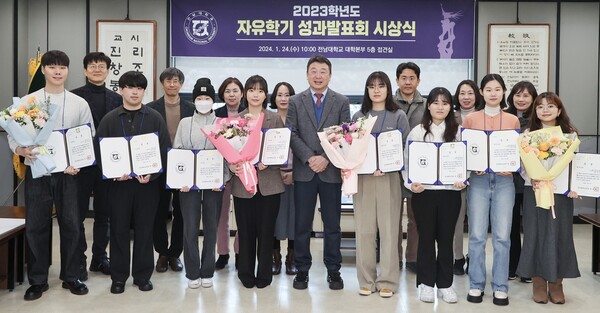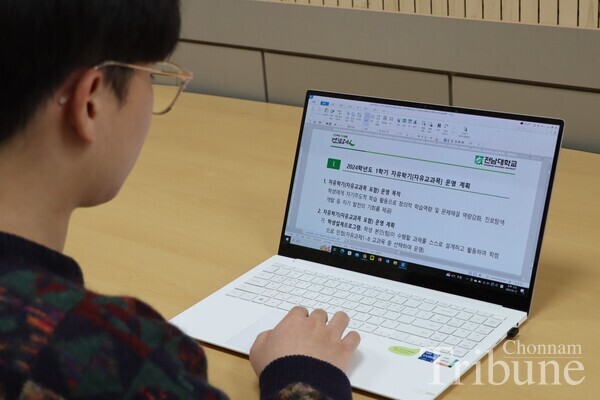
The Free Semester Program was first introduced at Chonnam National University in 2019, and it has been executed for six years this year. The purpose of the program is to help students get to know their interests and explore their capabilities through a range of learning activities. Over the last few years, however, the number of applicants for the program every semester rarely reaches two digits. Only four students applied for the program this semester, and all of them have been approved as participants. Based on the above-mentioned number of applicants in the program, it can be inferred that very few students are acquainted with the program. In this article, the Chonnam Tribune delved into the semester-long self-directed learning system on what it is exactly and how it has operated.
What the Free Semester System Is About
Put simply, the Free Semester Program is to let students earn credits by building plans for their self-designed projects and carrying them out in one semester. The core purpose of the program is to give students the opportunity to develop creative learning capabilities, problem-solving abilities, and career exploration through self-directed projects.
The work can be conducted in either of two paths: Free Semester and Free Subject types. The difference between these two types is whether it can be performed concurrently with regular courses. In contrast to the Free Semester program, which cannot be in parallel with other courses, the Free Subject program permits the option of simultaneous registration. Based on the plan designed by themselves, applicants determine the project type with credits assigned according to the time required for task completion: The Free Semester allows for a maximum of 15 credits, and up to three credits can be accepted for the Free Subject.
The program’s grading method is the Satisfactory/Unsatisfactory grading option. At the end of the semester, the grading of participant students is evaluated based on their performance through their plan proposal, and midterm and final reports.
What The Program Gives to Students
Since its introduction in the first semester of 2019, about 130 students have applied for the Free Semester Program, with approximately 90 percent of students successfully having their credits recognized. Considering that it has operated for six years in every regular and seasonal semester, the number of students is noticeably lacking. During the last regular semester, nine individuals were approved for application and final confirmation, including two teams of eight members and one individual. With only a few participants, one might wonder if the qualitative aspect of this program is being faithfully upheld.
Lee Ye-won (Senior, Dept. of Education), who conducted a Free Subject with her fellow students in the same department, said, “Through planning and executing the project on our own, I could broaden my meta-perspective on my major field of study. It was an enriching experience which is hard to attain solely through regular courses.” Under the guidance of their mentor professor, students interested in career paths beyond teaching formed a team. They embarked on a project aimed at identifying and seeking ways to overcome career barriers and limitations they face through case comparisons and interviewing graduates.
All the team members had something in common that they believed it was truly meaningful to work with people who share interests and struggles. Based on the joint vision, students could freely choose their topic and dig into their personal passions. Lee Ji-hae, a professor of the Department of Education who mentored the students above, also mentioned, “I felt unfortunate that students are practically unable to deeply explore their career paths while juggling regular coursework during the semester, and, therefore, I found this program valuable as it can fill the void."

What Is Needed More
The program, given a round of compliments, has, for a certain reason, failed to accompany more participants so far. What students think of the chief cause is that most students are simply unaware of the program. Lee David (Sophomore, School of Biological Sciences and Technology) said, “I would have at least considered giving it a try if I had known about such a program, but I had never heard of anything about it during school life.” The official in charge of the program at the Registrar’s Office said, “The participation rate of students often clumped in departments where it is relatively easier to design free-form projects, such as involving experiments and practical work. It leads to the limited sharing of such experiences, contributing to low participation.” It also converges to the same cause.
Students also mentioned the allocated budget as a reason for more extensive promotion. At the end of the semester, there is a performance showcase, sharing the outcomes of the projects. In the process, students can produce media content with financial support, and have a chance to be awarded cash prizes. Even though the content is uploaded on the university’s official YouTube channel, they still lack visibility.
The greatest challenge is to raise recognition for the students, yet there remains a bit more to improve. Prof. Lee pointed out, “Even if students recognize that there is a system for self-directed projects, it is surely hard for them to take on the challenge of leading something from start to finish on their own, especially without looking into precedents.” She also highlighted that what is crucial is not only student awareness but also the role of a mentor professor promoting participation and supporting the process.
Prospects of the Program
As society wants more and more of one’s autonomy and creativity, the autonomous learning program shows great promise of playing a principal role in developing those competencies in students. However, the current lack of sufficient activation of such a system, with the most significant factor being unawareness of its existence, is a great loss of excellent opportunities for students to improve themselves and the university can cultivate students’ talent.
Kim So-yeon (Senior, Dept. of Education) was willing to recommend the program to other students, saying, “As there was no set framework, I could freely try things I had not attempted before. Such a series of processes would be a meaningful experience to everyone, just like it was to me.” No set framework might initially be a reason for hesitation, but would ultimately be a key to achieving growth among students. This can only be accomplished through comprehensive efforts of the entire community on campus, including faculty, staff and students.
By Song Su-min, Editor

